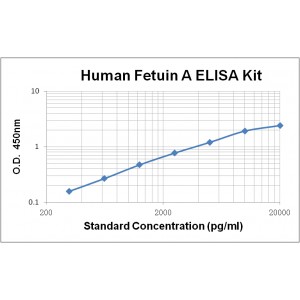More info
Assay Range | 312 -20,000 pg/mL |
Sensitivity | 10.0 pg/mL |
Size | 96T |
Storage | Store at 2 - 8ºC. Keep reconstituted standard and detection Ab at -20 ºC |
Assay Principle | Sandwich ELISA |
Sample Volume | 100 µL final volume, dilution factor varies on samples |
Detection Method | Chromogenic |
Kit Components
1. Recombinant Human Fetuin A standard: 2 vials
2. One 96-well plate coated with Human Fetuin A Ab
3. Sample diluent buffer: 12 mL - 1
4. Detection antibody: 130 µL, dilution 1:100
5. Streptavidin-HRP: 130 µL, dilution 1:100
6. Antibody diluent buffer: 12 mL x1
7. Streptavidin-HRP diluent buffer: 12 mL x1
8. TMB developing agent: 10 mL x1
9. Stop solution: 10 mL x1
10. Washing solution (20x): 25 mL x1
Background
Human Fetuin A, also known as α2-Heremans-Schmid glycoprotein (AHSG), Alpha-2-Z-globulin, or Ba-alpha-2-glycoprotein, is a member of the cystatin superfamily. Fetuin A is mainly produced by hepatocytes and monocytes/macrophages and is the most abundant in the plasma and in the bone. In the plasma, Fetuin A is a disulfide bond-linked two chain polypeptide consisting of two N-terminal cystatin domains and a smaller C-terminal domain. In the bone, Fetuin A is the most abundant non-collagenous protein. It accumulates in the bone through strong binding to apatite. Fetuin-A forms soluble complexes with calcium and phosphate and thus is a carrier of insoluble calcium phosphate. It is reported that purified bovine Fetuin A, when added into a solution supersaturated with calcium phosphate, is able to inhibit the precipitation of calcium phosphate mineral. Thus fetuin-A is a potent inhibitor of pathological calcification. Fetuin A knockout mice have increased risk for etopic calcification in blood vessels. In addition, it has been shown that serum levels of Fetuin A are significantly lower in end stage renal failure patients on long-term hemodialysis than in healthy controls. Sera from these patients show an impaired capacity to inhibit calcium phosphate precipitation. This impairment is corrected when purified Fetuin A is added. Therefore, decreased serum Fetuin A levels may contribute to accelerated vascular calcification in uremic patients. It is proposed that Fetuin A serum levels may be a useful biomarker to predict artery calcification and mortalities in renal failure patients. Recently, it has been shown that Fetuin A may play a role in endocytosis, brain development and the formation of bone tissue.


